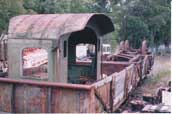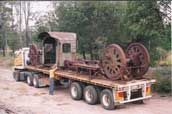![]() After many years, a dedicated group of Museum members have resumed clearing the
branchline of vegetation from the Dorrigo end of the line. This effort has two
purposes; to prevent damage to the track, from tree roots pushing the track bed
up and out of alignment, and also to allow the track bed to dry out, as retained
moisture increases the rate of decay of both rails and sleepers. Another benefit
of clearing the line is to enable us to look at the feasibility of transferring,
by rail, the remaining items of rollingstock stored on the line. This will be
entirely dependant on the condition of the line and, in particular, the numerous
wooden trestle bridges.
After many years, a dedicated group of Museum members have resumed clearing the
branchline of vegetation from the Dorrigo end of the line. This effort has two
purposes; to prevent damage to the track, from tree roots pushing the track bed
up and out of alignment, and also to allow the track bed to dry out, as retained
moisture increases the rate of decay of both rails and sleepers. Another benefit
of clearing the line is to enable us to look at the feasibility of transferring,
by rail, the remaining items of rollingstock stored on the line. This will be
entirely dependant on the condition of the line and, in particular, the numerous
wooden trestle bridges.
| |
|
|||||
|
This is a view of the line between the first and second level crossings. The picture is taken from a cleared patch, looking towards Megan. |
This is a view of "the burnt out bridge". We have cleared all the vegetation from the bridge itself, and are working on the deviation installed to bypass the bridge. |
This scene shows the result after we have passed through. We have cleared all of the major vegetation, which consisted primarily of privet and banksia, nicely bound together in the canopy by various vines. |
![]() Dismantled for overhaul in 1973, steam locomotive 3813 is a sister to
preserved loco's 3801, 3820 and 3830, but is considered by many
enthusiasts as long gone or written off. However 3813 has been making
progress towards re-assembly lately thanks to the efforts of our Museum
and the N.S.W. Rail Transport Museum. The locomotive's four largest
components were already at Dorrigo being the boiler, locomotive cast
steel frame, tender tank and tender underframe. The remaining 60 tonnes
of 3813's components that were in the R.T.M.'s care, including main
driving wheels and tender wheels, leading and trailing trucks, cab,
smokebox and hundreds of smaller items, were recently transported north
to Dorrigo by our Museum volunteers. The vast majority of 3813's
components are now in the one place for the first time in over thirty
years. This will facilitate its static restoration as a tribute to the
men of the former N.S.W.G.R. Cardiff Workshops. It is the sole
surviving locomotive constructed at that facility and was pride of
place at the 1955 N.S.W.G.R. Centenary Celebrations.
Dismantled for overhaul in 1973, steam locomotive 3813 is a sister to
preserved loco's 3801, 3820 and 3830, but is considered by many
enthusiasts as long gone or written off. However 3813 has been making
progress towards re-assembly lately thanks to the efforts of our Museum
and the N.S.W. Rail Transport Museum. The locomotive's four largest
components were already at Dorrigo being the boiler, locomotive cast
steel frame, tender tank and tender underframe. The remaining 60 tonnes
of 3813's components that were in the R.T.M.'s care, including main
driving wheels and tender wheels, leading and trailing trucks, cab,
smokebox and hundreds of smaller items, were recently transported north
to Dorrigo by our Museum volunteers. The vast majority of 3813's
components are now in the one place for the first time in over thirty
years. This will facilitate its static restoration as a tribute to the
men of the former N.S.W.G.R. Cardiff Workshops. It is the sole
surviving locomotive constructed at that facility and was pride of
place at the 1955 N.S.W.G.R. Centenary Celebrations.
 |
|
 |
|
 |
||
|
The parts of 3813 stored in S-Trucks at Thirlmere |
Some of the parts loaded on the Museum truck ready for transport to Dorrigo |
All parts of 3813 re-united at Dorrigo for the first time in 30 years |
![]() The Museum volunteers are working towards the limited public opening of
the static display, as funded by the combined Federal and State
Government Grants of $320 000 from the Federal Department of Transport
& Regional Services and the N.S.W Department of State &
Regional Development.
The Museum volunteers are working towards the limited public opening of
the static display, as funded by the combined Federal and State
Government Grants of $320 000 from the Federal Department of Transport
& Regional Services and the N.S.W Department of State &
Regional Development.
Here are some images of the Museum's bulldozer and self-elevating scraper in action.
![]() The Museum has purchased a strategic piece of land adjacent to the
branchline in Dorrigo. This 1 acre block adjoins our own 53 acre site
and encroaches within 5 metres of the railway line itself. The
construction of a new residence on the block was imminent, and after
much negotiation the Museum completed a sub-division and purchase of
the block to provide a strategic buffer zone. This was done to prevent
restrictions on future tourist train operations due to noise, smoke
etc., trains at that point climbing off a 1 in 30 gradient. Many other
tourist railways have restrictions and curfews imposed by suburbia
encroaching up to their boundary, indeed Puffing Billy in Victoria
actively purchases land adjacent to their line to preserve the
environment through which the line operates.
The Museum has purchased a strategic piece of land adjacent to the
branchline in Dorrigo. This 1 acre block adjoins our own 53 acre site
and encroaches within 5 metres of the railway line itself. The
construction of a new residence on the block was imminent, and after
much negotiation the Museum completed a sub-division and purchase of
the block to provide a strategic buffer zone. This was done to prevent
restrictions on future tourist train operations due to noise, smoke
etc., trains at that point climbing off a 1 in 30 gradient. Many other
tourist railways have restrictions and curfews imposed by suburbia
encroaching up to their boundary, indeed Puffing Billy in Victoria
actively purchases land adjacent to their line to preserve the
environment through which the line operates.